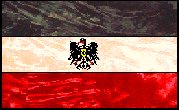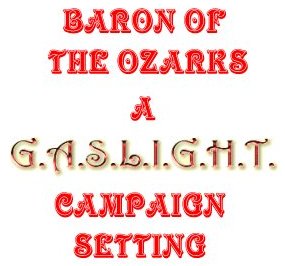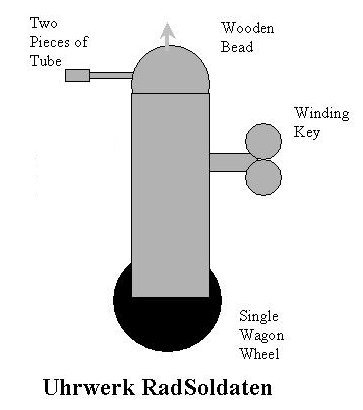


|
|
 |
 |
FLASH! BATTLE ON THE FLORIDA COAST! A MIXED LANDING FORCE OF AMERICAN AND TEXAN DEALS THE HATED PRUSSIAN A HEAVY BLOW IN THE CARRIBEAN! SEE THE BATTLE REPORT!
![]() OUTRAGE!!!! The Prussian Hobnailed BOOT
descends on the sleepy town of Buzzard's Gulch, Texas! WOMEN
VIOLATED! COWS RUSTLED!! The DEAD PILED IN THE STREETS!
How long must this endure?
OUTRAGE!!!! The Prussian Hobnailed BOOT
descends on the sleepy town of Buzzard's Gulch, Texas! WOMEN
VIOLATED! COWS RUSTLED!! The DEAD PILED IN THE STREETS!
How long must this endure?
SEE INCIDENT REPORT
I'm working on a GASLIGHT scenario I'm calling "The Baron of the Ozarks" which postulates a Prussian invasion of the USA. With a little bit of luck and some imagination, I may have the makings for a long campaign.
DATELINE, 1871
Essentially, the Prussian General Staff realized early on that in order to have access to the lucrative and nascent coal-gas industry cropping up in lower Texas and Mexico, Prussia would, somehow, have to strike a strategic blow to neutralize America's reaction to the crisis of seizing the coal-gas fields. The invention of the Uhrwerk RadSoldaten (Clockwork Wheelsoldiers) provided Prussia with a cheap source of artificial manpower to swell the ranks of the invasion force.
 |
Inspiraton: Vaughn Bode's JUNKWAFFEL series |
The artificially-augmented Prussian invasion forces will do well against a conventional force, but they are insufficient in number to take and hold large portions of the USA without a drain on Prussian manpower that would threaten Prussia's holdings overseas. Thus, the New Fedualism concept took hold. The Prussian *junkers* made common cause with the disaffected upper class Southerners, still smarting from recent defeat in the American Civil War. In return for mustering local militias to administrate and hold large portions of conquered America, the Prussians elevated certain of the more rabid ex-confederate leaders into titled nobility. In due course, Nathan Forrest became Governor-General of New Orleans, Jefferson Davis the Duke of Lower Mississippi, and Earl Van Dorn the Baron of the Ozarks. These are not empty titles. The "new nobility" exercise tremendous power over their fiefdoms, with the authority to be as ruthless as they please, as long as coal-gas quotas are kept up.
Early to Late 1871
The US reaction is at first indecisive as the Grant Administration collapses in the turmoil of blame, counter-blame and recrimination following the Prussian landings in Mississippi, Louisiana, and East Texas. Grant, disgusted, resigned the presidency in favor of William Seward, then acting Vice-President. Within 24 hours of his resignation, Grant took field command of forces opposing the invasion in Lousiana. Over the next four months, the American position deteriorated in the aftermath of four key battles. The last of these, Beaumont, shattering the salient Grant had made in Prussian lines that Fall. Three key factors led to Grant's failure: the introduction of a widespread resurgent Confederate militia to bolster Prussian manpower, the introduction of the Uhrwerk RadSoldaten in large numbers, and profilgate commitment of Prussian Landship reserves. Grant never had a chance.
Grudingly, the American High Command retreated behind the Truce Line (roughly, The Indian Territory border, the top part of Lousiana, West Texas, and the Alabama Border)-- to rebuild a new two-pronged invasion force under Generals Lee and Sheridan. The choice of Lee was an anathema to some; Lee still did not enjoy American citizenship as a result of his Civil War role, and though he was widely respected, his appointment was met with much head-wagging among the political forces in Washington.
Efforts Abroad, early 1872
The bald-faced land grab by Prussia was met with dismay in the English and French Parliments, and motions were carried to voice the strongest objections to it. Intervention was sought by the same group of diplomats who had, years before, deftly maneuvered Britain and France towards intervention in Civil War. So far, the "Great Powers" were reluctant to confront their European rival on American soil.
Mid-1872
While the Army of the Reconquest was rebuilding, the new conquerors realized they were not being greeted with joyous acclaim, especially on the fringes of the old so-called "Deep South" states. Texas, in particular, proved to be an iconoclasm: it had joined the Confederacy willingly enough, but New Feudalism left a bad taste in their mouths. The Forces of Occupation began to be met with pockets of armed resistance. A coalition of six small towns located near a critical coal-gas rendering factory in the Northwest corner of the State grew particularly troublesome. The citizenry reacted strongly to the Prussian Revenue Agency when it attempted to levy tribute from the county, leaving three rather startled Junkers swinging from lamp posts. The townsmen officially (and rather bluntly) informed the next Prussian official to enter then county that he was officially standing on the sovereign terrain of of the Republic of Texas, and he would have to leave forthwith or be shot. The Prussian reaction was swift and brutal. An entire regiment of Prussian Regulars, augmented by Uhrwerk Radsoldaten, with two smaller Resurgent Confederate militia groups in tow, marched South from the Arkansas Truce Line to smash rebellion in this part of Texas. Leadership was given to Earl Van Dorn, the newly appointed "Baron of the Ozarks."
Against this military might, the Texans seemed doomed. However,
they were not without resources of their own. Four whole companies
of Amercian Dragonfly Lancers had been cut off from the main body of the
Army during the disasterous Battle of Beaumont, and they had found a
welcome home within the new "Republic of Texas" . The Texas Rangers,
as well, were not totally destroyed-- they could muster four companies of
Rangers and still had two galvanic War Wagons of the Ciudad class
available to them-- the "Sweetheart of the Rodeo" and the "El
Diablo".
To this amazing polyglot was added a citizens' militia drawn
from the surrounding counties. Undeterred by the nearly 3 to 1
discrepancy in forces, the Forces of the Republic of Texas dug in and
waited, worriedly looking East for help that would not be forthcoming
from the United States.
SCENARIO ONE: The Battle of Chalupa Flats
this page copyright 2001 Walter O'Hara